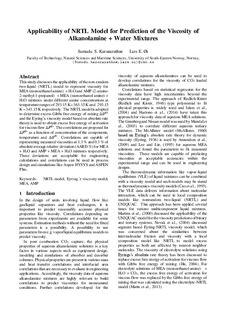| dc.contributor.author | Karunarathne, Sumudu S. | |
| dc.contributor.author | Øi, Lars Erik | |
| dc.date.accessioned | 2020-01-28T12:32:37Z | |
| dc.date.available | 2020-01-28T12:32:37Z | |
| dc.date.created | 2020-01-23T20:13:18Z | |
| dc.date.issued | 2019 | |
| dc.identifier.citation | Linköping Electronic Conference Proceedings. 2020, 170, 73-77. | nb_NO |
| dc.identifier.issn | 1650-3686 | |
| dc.identifier.uri | http://hdl.handle.net/11250/2638340 | |
| dc.description | Linköping University Electronic Press use a Creative Commons licensing system. Readers may download, read, distribute and use material from published publication on LiU E-press for non-commercial use only as long as they give complete attribution to the authors i.e. full reference to the author and the original publication. | nb_NO |
| dc.description.abstract | This study discusses the applicability of the non-random two-liquid (NRTL) model to represent viscosity for MEA (monoethanol amine) + H2O and AMP (2-amino-2-methyl-1-propanol) + MEA (monoethanol amine) + H2O mixtures under different amine concentrations at temperature ranges of 293.15 K– 363.15 K and 293.15 K – 343.15 K respectively. The NRTL model is adopted to determine excess Gibbs free energy of mixing and the Eyring’s viscosity model based on absolute rate theory is used to obtain excess free energy of activation for viscous flow. The correlations are proposed for the viscous flow as a function of concentration of the components, temperature and Gibbs free energy. Correlations are capable of representing measured viscosities at 1.3% and 0.3% of absolute average relative deviation (AARD %) for MEA + H2O and AMP + MEA + H2O mixtures respectively. These deviations are acceptable for engineering calculations and correlations can be used in process design and simulations like Aspen HYSYS and ASPEN Plus. | nb_NO |
| dc.language.iso | eng | nb_NO |
| dc.rights | Navngivelse-Ikkekommersiell 4.0 Internasjonal | * |
| dc.rights.uri | http://creativecommons.org/licenses/by-nc/4.0/deed.no | * |
| dc.title | Applicability of NRTL Model for Prediction of the Viscosity of Alkanolamine + Water Mixtures | nb_NO |
| dc.type | Journal article | nb_NO |
| dc.type | Peer reviewed | nb_NO |
| dc.description.version | acceptedVersion | nb_NO |
| dc.source.pagenumber | 73-77 | nb_NO |
| dc.source.volume | 170 | nb_NO |
| dc.source.journal | Linköping Electronic Conference Proceedings | nb_NO |
| dc.identifier.doi | 10.3384/ecp2017073 | |
| dc.identifier.cristin | 1781186 | |
| cristin.unitcode | 222,58,3,0 | |
| cristin.unitname | Institutt for prosess-, energi- og miljøteknologi | |
| cristin.ispublished | true | |
| cristin.fulltext | postprint | |
| cristin.qualitycode | 1 | |

